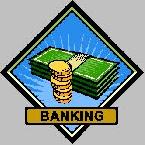
 |
|
| Financial Terms | |
| Bad debt |
|
Information about financial, finance, business, accounting, payroll, inventory, investment, money, inventory control, stock trading, financial advisor, tax advisor, credit.
Main Page: financial, finance, inventory, money, business, credit, investment, inventory control, |
Definition of Bad debt
Bad debtAn account receivable that cannot be collected.
Related Terms:Bad debtsThe amount of accounts receivable that is not expected to be collected. bad debtsRefers to accounts receivable from credit sales to customers Allowance for bad debtsAn offset to the accounts receivable balance, against which accounts receivableShort-term, non-interest-bearing debts owed to a mark to marketRefers to the accounting method that records increases Debt/equity ratioIndicator of financial leverage. Compares assets provided by creditors to assets provided DebtMoney borrowed.  Debt capacityAbility to borrow. The amount a firm can borrow up to the point where the firm value no Debt displacementThe amount of borrowing that leasing displaces. Firms that do a lot of leasing will be Debt instrumentAn asset requiring fixed dollar payments, such as a government or corporate bond. Debt leverageThe amplification of the return earned on equity when an investment or firm is financed Debt limitationA bond covenant that restricts in some way the firm's ability to incur additional indebtedness. Debt marketThe market for trading debt instruments. Debt ratioTotal debt divided by total assets. Debt reliefReducing the principal and/or interest payments on LDC loans. Debt securitiesIOUs created through loan-type transactions - commercial paper, bank CDs, bills, bonds, and  Debt serviceInterest payment plus repayments of principal to creditors, that is, retirement of debt. Debt service parity approachAn analysis wherein the alternatives under consideration will provide the firm Debt-service coverage ratioEarnings before interest and income taxes plus one-third rental charges, divided Debt swapA set of transactions (also called a debt-equity swap) in which a firm buys a country's dollar bank Debtor in possessionA firm that is continuing to operate under Chapter 11 bankruptcy process. Debtor-in-possession financingNew debt obtained by a firm during the Chapter 11 bankruptcy process. Firm's net value of debtTotal firm value minus total firm debt. Funded debtdebt maturing after more than one year. Interest rate on debtThe firm's cost of debt capital. Junior debt (subordinate debt)debt whose holders have a claim on the firm's assets only after senior Long-term debtAn obligation having a maturity of more than one year from the date it was issued. Also  Long-term debt/capitalizationIndicator of financial leverage. Shows long-term debt as a proportion of the Long-term debt ratioThe ratio of long-term debt to total capitalization. Long-term debt to equity ratioA capitalization ratio comparing long-term debt to shareholders' equity. Original issue discount debt (OID debt)debt that is initially offered at a price below par. Secured debtdebt that, in the event of default, has first claim on specified assets. Senior debtdebt that, in the event of bankruptcy, must be repaid before subordinated debt receives any payment. Structured debtdebt that has been customized for the buyer, often by incorporating unusual options. Subordinated debtdebt over which senior debt takes priority. In the event of bankruptcy, subordinated Total debt to equity ratioA capitalization ratio comparing current liabilities plus long-term debt to Trade debtAccounts payable. Unfunded debtdebt maturing within one year (short-term debt). See: funded debt. Unsecured debtdebt that does not identify specific assets that can be taken over by the debtholder in case of default. RATIO OF DEBT TO STOCKHOLDERS’ EQUITYA ratio that shows which group—creditors or stockholders—has the biggest stake in or the most control of a company: DebtBorrowings from financiers. DebtorsSales to customers who have bought goods or services on credit but who have not yet paid their debt. debt-to-equity ratioA widely used financial statement ratio to assess the Cost of DebtThe cost of debt (bonds, loans, etc.) that a company is charged for Debt RatioThe percentage of debt that is used in the total capitalization of a Total Debt to Total Assets RatioSee debt ratio DebtFunds owed to another entity. Long-term debtA debt for which payments will be required for a period of more than funded debtdebt with more than 1 year remaining to maturity. MM's proposition I (debt irrelevance proposition)The value of a firm is unaffected by its capital structure. secured debtdebt that has first claim on specified collateral in the event of default. subordinated debtdebt that may be repaid in bankruptcy only after senior debt is paid. Debt InstrumentAny financial asset corresponding to a debt, such as a bond or a treasury bill. Monetizing the DebtSee printing money. National DebtThe debt owed by the government as a result of earlier borrowing to finance budget deficits. That part of the debt not held by the central bank is the publically held national debt. Public DebtSee national debt. Publicly Held National DebtSee national debt. Debt SecurityA security representing a debt relationship with an enterprise, including a government EBBS - Earnings before the bad stuffAn acronym attributed to a member of the Securities and Debt CapacityAn assessment of ability and willingness to repay a loan from anticipated future cash flow or other sources. Debt FinancingRaising loan capital through the creation of debt by issuing a form of paper evidencing amounts owed and payable on specified dates or on demand. Debt/Equity RatioA comparison of debt to equity in a company's capital structure. Long Term DebtLiability due in a year or more. Mezzanine DebtRefers to non-conventional debt that has a greater element of risk than secured debt but has less risk than equity. Senior DebtAre debt instruments that provide financing, take primary security against either specific or all assets of the borrower, have fixed terms of repayment and charge fixed or floating interest rates. Subordinated Debtdebt instruments that provide financing for acquisitions, expansion and restructuring, take secondary security against assets, have fixed or flexible terms of repayment and charge fixed or floating interest rates. Debt (Credit Insurance)Money, goods or services that someone is obligated to pay someone else in accordance with an expressed or implied agreement. debt may or may not be secured. Related to : financial, finance, business, accounting, payroll, inventory, investment, money, inventory control, stock trading, financial advisor, tax advisor, credit. |